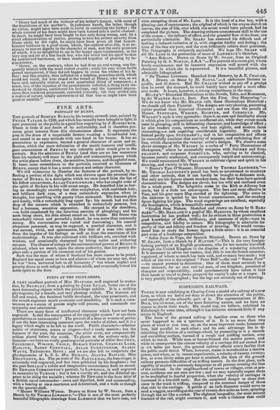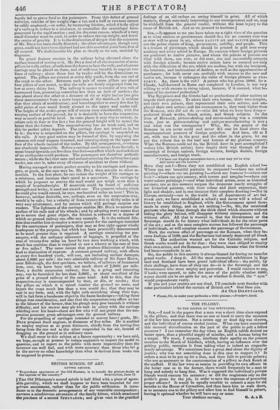SUSPENSION RAILWAYS.
THERE IS now exhibiting at Charing Cross a model of a railway of anew form, to which we feel it our duty to direct the attention of the public, and especially of the scientific part of it. The representations of Mr. Dxcx, the inventor, are of the most flattering nature, and we have no reason to doubt their truth. His model was, we believe, exhibited in Edinburgh for some time, although it has hitherto attracted little if any notice in England. The form of the ground railway is familiar even to those who never happened to see a specimen of it. It is no more than two pieces of wood or cast iron, or, on the most improved roads, hammered iron, laid parallel to each other ; and its sole advantage lies in di- minishing the friction of a carriage-wheel, by presenting to it a smooth and unyielding surface, instead of a rough and yielding surface, over which to travel. While men or horses formed the motive power, and while in consequence the utmost velocity of a carriage did not exceed five or six miles per hour, the ground railway offered every facility that the public could desire. When, however, steam is introduced as a motive power, and when, as in recent experiments, a velocity of twenty, twenty- five, or even thirty miles per hour is attained, the form of the ground railway presents difficulties of no trifling nature. In the first place, such rapidity of motion is extremely dangerous to all persons crossing the line of the railroad. In the neighbourhood of towns or villages, even at pre.. sent, accidents are not rare nor few ; and we may naturally expect them to be multiplied in fearful proportion, when the velocity of carriages is increased in a five-fold ratio. But the occasional danger to those that come in the track is trifling, compared to the constant danger of those that ride in the carriage. A pebble of an inch diameter would serve to send a waggon, travellingat the rate of twenty-five miles an hour, spinning through the air like a rocket. The slightest inequality, the most minute fracture of the rail, might overturn it, and with a violence that could hardly fail to prove "fatal to the Pasiengers. From this defect of ground railways, vehicles of less weight than a ton and a half or two tons cannot be safely employed,—in order, by increasing friction, which it is the object 0/a railway to reduce to a Minimum, to neutralize the centrifugal force generated by the rapid motion ; and, for the same reason, wheels of a very small diameter must he used, it order to reduce the top weight, and lower the centre of gravity. It is to the diminution of danger that the attention of Mr. IN c x has been chiefly directed ; the other advantages, though very great, could not have been attained had not this essential point been first of all secured. We shall describe his plan as clearly as we can, unaided by diagrams.
Its grand feature consists in the railway being .elevated above the surface instead of resting on it. Mr. Dicx first of all erects a series of stone pillars,'or walls rather, of sufficient thickness to bear the rails, and whatever .carriage may be placed on them, and of sufficient breadth to support two lines of railway : about three feet by twelve will be the dimensions re- quired. The pillars are erected at every fifty yards, from the one end of the track to the other. Between each pair of stone pillars are placed four pillars of cast metal, so that the rails are firmly supported from be- low at every thirty feet. The railway is meant to consist of two rods of hammered iron, presenting somewhat less than an inch of surface ; the one placed above the other at a distance of six or eight inches (we give these measurements from a mere inspection of the model—it is evident that they admit of modification), and bound together at every five feet by solid pieces of cast metal firmly riveted to the upper and under rail. The height of the under-props will of course vary considerably, with the varying surface of the ground, for it is desirable to have the suspension_ way as nearly as possible level. In some places it may rise to twenty, in others only to four or five feet ; but the general height will be nearer the latter than the former. The suspension-way has no track road, and on this its perfect safety depends. The carriage does not travel on it, but In it ; the way is suspended on the pillars, the carriage is suspended on the rails. A very good notion may be formed of this, by supposing the common rail-road waggon inverted, and coursing along on the upper sur- face of the wheels instead of the under. By this arrangement, overturns are absolutely impossible. Before a carriage could escape from the rails, it must bound upwards not less than four feet—an effect which no shock short of an earthquake could produce. The passengers are therefore perfectly secure ; while the fact that men and animals crossing the railwaymust pass under, not over it, takes away all chance of accident to those without.
Having managed to attain perfect security to his carriages and passen- gers, or goods, as the case may be, Mr. DICK then attends to other es- sentials. In the first place, he can reduce the weight of his carriages to a minimum, and increase their speed to a maximum. The carriage by which he proposes to convey the mail would not weigh more than a couple of hundredweight. If materials could be found of sufficient -strength and levity, it need not exceed one. The greatest velocity which he could give would exceed, he says, one hundred miles an hour ! This is, however, neither desirable, nor, perhaps, even on the suspension-way, would it be safe ; but a velocity of from twenty-five to thirty miles is of very easy attainment, and by means which will perhaps surprise our readers. The lightness of the carriage enables Mr. DICK to narrow the surface of his rails and of his wheels ; and by adopting every means that go to secure that great object, the friction is reduced to -a -degree- of which no ground railway can offer any example. It is the reduced fric- tion that enables him to employ a motive power for the carriages intended for the conveyance of passengers, that may at first sight appear wholly Inadequate to the purpose, but which has been practically demonstrated to be much greater than is required. A carriage containing ten pas- sengers, with the ordinary allowance of luggage, Is propelled at the rate of twenty-five miles an hour by two men working a winch, with much less exertion than is required to row a wherry at the rate of four or five miles ! The same causes that -produce diminution of friction lead to diminution of expense. A common ground railway, with offsets at every five hundred yards, will cost, not including surface damages, about 4,000/. per mile : the very admirable railway of Sir JOHN HOPE, near Edinburgh, the first specimen, we believe, of railways of hammered iron, cost, we have been told, not much short of 7,000/. per mile. Now, a double suspension railway, that is; a going and returning way, can be furnished for less than 3,000/., or about one-third of the price of a ground railway of the same kind. Add to this, that the suspension-way is unaccompanied by dust, or din, or smoke ; - that the pillars on which it is raised cumber the ground no more, and injure the crops much less than a tree would do ; that they may be cast in any form, and, with the light rails stretching along their tops, will in fact form a handsome object in the finest landscape ;—taking these things into consideration, and also that the suspension-way offers no bar to the labours of the farmer, that his plough may pass beneath it without difficulty, and his mower may ply his task in safety with the carriage whirling over his head—there are few who will not grant that the sus- pension possesses great advantages over the ground railway.
For the propelling of carriages intended to convey heavy goods, Mr. Dics proposes fixed engines, at distances of five miles. He is enabled to employ engines at so great distances, chiefly from the towing-line being from the one end to the other suspended in the air, instead of dragging on the ground as in ordinary cases.
We shall recur to this subject at a future opportunity : we have said, -we hope, enough at present to induce engineers to inspect the model in question, and to report to the public with more impartiality than the Inventor can well feel, and with more accuracy than those who bri g to the survey no other knowledge than what is derived from books can be supposed to possess.



























 Previous page
Previous page